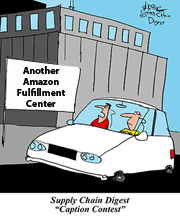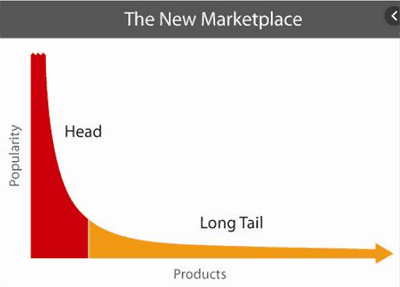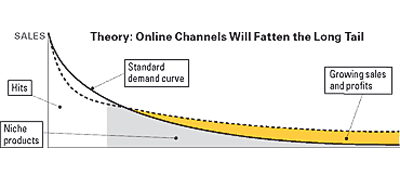 |
September 13, 2019 - Supply Chain Flagship Newsletter |
 |
|
||||||||||
 |
|
||||||||||||||||||||||||||||||||||||||||||||||||||||||||||||||||||||||||||||||||||||||||||||||||||||||||||||||||||||||||
|
|||||||||||||||||||||||||||||||||||||||||||||||||||||||||||||||||||||||||||||||||||||||||||||||||||||||||||||||||||||||||
What made Anderson's insight take on this unique and useful was his view how all this was changing as a result of the Internet. First, the retail channel presents a true constraint in terms of physical shelf space. Only so many SKUs in a category will be stocked and displayed. Second, there are many costs associated with that distribution model, from shipping to the retail DC by the manufacturer and then to the store by the retailer, and in terms of inventory carrying costs. I've seen data many times on the incredible percent of products at large retail outlets that move just one time per week or less on average. This all changes in an ecommerce world, Anderson noted. First, there are much fewer constraints in storing products in comparatively cheap distribution center space versus a retail shelf. Second the internet and direct-to-customer shipping allows the seller to aggregate demand across the entire market. So, a SKU that sells less than once a week in each store might sell quite a few each week if demand is consolidated across the country. These two things together mean that (a) there would be still more products in the tail, making it longer; and (b) the tail would also grow fatter (more sales per SKUs in the tail), because customers could buy products that more precisely meet their needs and find more of these products through search technologies, as shown in the second graphic below. |
|||||||||||||||||||||||||||||||||||||||||||||||||||||||||||||||||||||||||||||||||||||||||||||||||||||||||||||||||||||||||
All of that meaning that long tail SKUs together increasingly really add up to something meaningful, and could be increasingly profitable individually and collectively when sold through ecommerce. The "80/20" principle would no longer hold. Those thoughts as a prelude to some recent musings I have had on how supply chain generally and Amazon specifically are impacting long tail thinking and execution. So consider Home Depot, which carries I believe more than a hundred thousand SKUs in its giant stores. Many of those are long tail, slowing moving products, but Home Depot carries many marginal SKUs because it knows if customers come in and can't find what they are looking for they may not come back the next time. But in recent years Home Depot has built three ecommerce DCs, which stock something like one million SKUs. These hundreds of thousands of additional SKUs are by definition long tail products, but now demand for them is aggregated across three major facilities. But while those three ecom DCs gave Home Depot two-day ground shipping to an huge percent of the US population, that wasn't enough in Amazon world. So now Home Depot is building out almost 200 local fulfillment centers that can provide next day or same day deliveries in many markets - for fast moving SKUs in the head not the tail, though I assume there will also be some cross docking capabilities as part of that mission. An interesting application of long tail thinking indeed. I will also quickly reference the "endless" aisle concept and vendor drop shipping that add even more SKUs to a retailer's assortment. But then you have Amazon, ever pushing the envelope. I suspect but do not know that Anderson's long tail vision imagined these slow moving and niche SKUs being fulfilled from centralized distribution facilities. That would imply shipping of at least a couple of days, and cost for faster service. In April, Amazon announced it was transitioning its Prime service benefits to offer next day shipping for free, from the previous two-day program. It also just spent $800 million just in Q2 to build the needed capabilities. And add one more thing: As Art Mesher, inventor of the "Three V's of Supply Chain" noted a couple of years ago at a CSCMP conference the role of Amazon algorithms in determining what products are displayed and an what sequence, with search result that are no doubt what is best for Amazon. What is your view of the Long Tail? Is Amazon turning it upside down? Let us know your thoughts at the Feedback button below. |
|||||||||||||||||||||||||||||||||||||||||||||||||||||||||||||||||||||||||||||||||||||||||||||||||||||||||||||||||||||||||
|
|
|
YOUR FEEDBACK
Some of the short feedbacks on our recent columns summarizing the 2019 State of Logistics report from CSCMP. Here are a few.
Feedback on State of Logistics Report Coverage.
![]()
SCDigest does an amazing job with this. You take a very long document and boil it down to its essence in just one or two columns.
This is a great service to the industry - thank you.
Michelle Watson
Ft. Wayne, IN

![]()
I agree with you on the timing. By the time the report shows in late June, my interest in 2018 data has faded. We're already starting to look ahead to the next year.
I don't have a magic wand on how this could be changed to get the report out earlier, but it would make it much more valuable.
Mark Fitz
Stow, OH

![]()
It would be very interesting to know logistics costs as a percent of GDP in other countries. Can this be provided?
Amy Danko
Kansas City
Editor's Note:
We'll see what we can do.

![]()
I really like the way you take a long report and break it down into the key statistic. It's a pleasure to read, and I watched the excellent video summary itself on the Video News.
Brian Toomay
Atlanta
SUPPLY CHAIN TRIVIA ANSWER
Q:How many women have won CSCMP's Distinguished Service Award?
A: 3 in 45 years - Ann Drake (DSC Logistics), Nancy Nix (TCU, more), and this year's winner, Kathy Wengel (Johnson & Johnson).
| © SupplyChainDigest™ 2003-2019. All Rights Reserved. SupplyChainDigest PO Box 714 Springboro, Ohio 45066 |
POWERED BY: XDIMENSION
|













